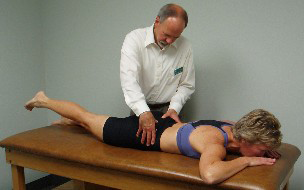Hip Extension Test
How to Perform
Step 1: The patient is lying prone and the examiner palpates the gluteus maximus for activation during hip extension. Janda originally described an ideal hip extension firing pattern in which the hamstrings fired first followed by the gluteus maximus then the contralateral and finally ipsilateral lumbar erector spinae. (Janda, 1990). Subsequent studies have not supported this firing pattern. (Pierce and Lee, 1990; Vogt and Banzer, 1997). Clinically what seems to be most important is whether or not the gluteus maximus fires at all and how well are the pelvis and trunk stabilized during hip extension.
Step 2: The second part of the hip extension test is for the examiner to monitor the PSISs during active hip extension. Normally the PSISs should stay still or move slightly superior during the movement.


